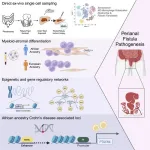(Press-News.org) BIRMINGHAM, Ala. – Adverse life events are a known and predominant risk factor for postpartum depression in women after delivery of their baby. Furthermore, the postpartum depression in women who have experienced adverse life events tends to be refractory to treatment.
In a study using a mouse model and human subjects, researchers from the University of Alabama at Birmingham and Johns Hopkins Medicine show that stress from adolescent social isolation in mice elicits a prolonged elevation of corticosterone levels and glucocorticoid signaling, which in turn results in long-lasting postpartum behavioral changes indicative of depression. Importantly for clinically relevant biology, this was associated with prolonged dysregulation of the neuro-hormone system that manages stress, called the hypothalamic-pituitary-adrenal, or HPA, axis.
Similar to the mouse results, the researchers found that childhood or adolescent stress significantly impacted HPA axis dysregulation and postpartum depression in a study of 116 women.
“We believe that the discovery in the present study sheds light on the relationship between adolescent stress and postpartum behavioral changes, bridging a major knowledge gap in the understanding of postpartum depression,” said Minae Niwa, Ph.D., an associate professor in the UAB Department of Psychiatry and Behavioral Neurobiology.
“Most importantly, we demonstrated that a short-term, one-week, postdelivery treatment against this pathological mechanism was sufficient to block the behavioral changes in stressed mouse dams, whereas other medicines currently used for postpartum depression in the clinical setting are ineffective,” Niwa said. The effective treatment used a glucocorticoid receptor antagonist, a drug not currently used to treat postpartum depression. This antagonist, which blocks the effects of elevated glucocorticoids (cortisol in humans and corticosterone in rodents), could be a novel treatment option for postpartum depression.
Niwa and Akira Sawa, M.D., Ph.D., director of the Johns Hopkins Schizophrenia Center and professor in the Johns Hopkins University School of Medicine, are co-corresponding authors of the study, published in Nature Mental Health.
The current first-line pharmacological treatment for postpartum depression is selective serotonin uptake inhibitors; but only half of patients respond to those, indicating a need for novel pharmacological treatments. Furthermore, symptomatic relief only appears several weeks after initial medication. In the most severe and resistant cases, women can receive IV infusions of drugs that target GABAA receptors. However, these calming infusions cost more than $34,000 for a single course and often require hospitalization. In addition, the FDA recently approved oral administration; but the need for follow-up, long-term remission and insurance coverage are not clear.
Postpartum depression is estimated to occur in 7 percent to 20 percent of all women, most commonly within six weeks of giving birth. Symptoms include feelings of sadness, anxiety and fatigue, and can make it difficult to complete basic self-care tasks and care for the new baby.
The stress in the mouse model study was social isolation during adolescence, in contrast to the normal group housing for mice. Stressed and unstressed mice were bred or left virgin, creating four experimental groups. Compared to the stressed and unstressed virgins and the unstressed dams, the stressed mothers at seven days postpartum showed decreased social communication, increased immobility and a decreased sucrose preference, all considered markers for depression. These traits persisted for at least three weeks after delivery.
In a second and most critical step, the researchers tested plasma levels of several hormones and found the level of corticosterone — a stress response hormone — was increased during pregnancy and delivery in mothers both with and without adverse early life experiences. However, corticosterone levels in unstressed mothers decreased to normal levels after delivery, while the levels in stressed mothers with adverse early life experiences remained high for one to three weeks after birth. This suggests a correlation between prolonged postdelivery elevation of corticosterone and behavioral changes in postpartum mice who experienced social isolation in adolescence.
The novelty of this study, researchers say, lies in discovering and defining the role and mechanism of the HPA axis and glucocorticoid signaling in the context of postpartum depression.
Co-authors with Niwa and Sawa in the study, “Prolonged HPA axis dysregulation in postpartum depression associated with adverse early life experiences: a cross-species translational study,” are Sedona Lockhart, Daniel J. Wood, Kun Yang, Gary S. Wand and Jennifer L. Payne, Johns Hopkins University School of Medicine; and Jose Francis-Oliveira, Kyohei Kin, Adeel Ahmed and Shin-ichi Kano, UAB Department of Psychiatry and Behavioral Neurobiology.
Support came from National Institutes of Health grants MH092443, MH094268, K99MH-094408, MH105660, MH107730, DA040127 and MH116869; and the Brain and Behavior Research Foundation.
At UAB, Psychiatry and Behavioral Neurobiology is a department in the Marnix E. Heersink School of Medicine.
END
Postpartum depression after adolescent stress shows a dysregulated HPA axis: a cross-species translational study
This serious mental health problem resists treatment, but a mouse model shows a potential new treatment
2024-04-24
ELSE PRESS RELEASES FROM THIS DATE:
When studies conflict: building a decision-support system for clinicians
2024-04-24
One day you hear that red wine is good for your heart. The next day, it’s not. The same goes for chocolate. And coffee. The see-saw of contradicting information isn’t anything new, but what happens when clinicians hear conflicting studies about a medication they use for their patients? Researchers at the Perelman School of Medicine at the University of Pennsylvania are hoping to use, among other methods, a variety of artificial intelligence to help sort that out.
Ellen Caniglia, ScD, an assistant professor of Epidemiology and Enrique Schisterman, PhD, a professor and the chair of the Department of Biostatistics, Epidemiology, and Informatics (DBEI), ...
Artificial sweetener has potential to damage gut
2024-04-24
New research has discovered that neotame, one of the new generation of artificial sweeteners, is capable of damaging the human intestine and causing illness.
The study is the first to show that neotame can cause previously healthy gut bacteria to become diseased and invade the gut wall – potentially leading to health issues including irritable bowel syndrome and sepsis – and also cause a breakdown of the epithelial barrier, which forms part of the gut wall.
The research, which is published in the journal Frontiers in Nutrition and was carried out at Anglia Ruskin ...
Gene-based therapy restores cellular development and function in brain cells from people with Timothy syndrome
2024-04-24
In a proof-of-concept study, researchers demonstrated the effectiveness of a potential new therapy for Timothy syndrome, an often life-threatening and rare genetic disorder that affects a wide range of bodily systems, leading to severe cardiac, neurological, and psychiatric symptoms as well as physical differences such as webbed fingers and toes. The treatment restored typical cellular function in 3D structures created from cells of people with Timothy syndrome, known as organoids, which can mimic the function of cells ...
MD Anderson Research Highlights for April 24, 2024
2024-04-24
HOUSTON ― The University of Texas MD Anderson Cancer Center’s Research Highlights showcases the latest breakthroughs in cancer care, research and prevention. These advances are made possible through seamless collaboration between MD Anderson’s world-leading clinicians and scientists, bringing discoveries from the lab to the clinic and back.
Recent developments at MD Anderson offer insights into a novel targeted therapy for rare cancers, the role of enhancer RNAs in cell differentiation, novel biomarkers for the prognosis and treatment of pancreatic cancer, imaging signatures to stratify ...
Child pedestrians, self-driving vehicles: What’s the safest scenario for crossing the road?
2024-04-24
Crossing a busy street safely typically is a result of a social exchange. Pedestrians look for cues—a wave, a head nod, a winking flash of the headlights, and, of course, a full vehicle stop—to know it’s safe to cross.
But those clues could be absent or different with self-driving vehicles. How will children and adults know when it’s safe to cross the road?
In a new study, University of Iowa researchers investigated how pre-teenage children determined when it was safe to cross a residential street with oncoming self-driving cars. The researchers found children made the ...
Mount Sinai researchers the first to apply single-cell analysis to reveal mechanisms of a common complication of Crohn’s disease
2024-04-24
Mount Sinai researchers have published the first study to use single-cell analysis in identifying several pathophysiological mechanisms of abnormal passageways in the digestive system known as perianal fistulae, a common complication of Crohn’s disease. These findings were published in the journal Med on April 24.
Crohn’s disease is an inflammatory bowel disease that causes chronic inflammation at any part of the gastrointestinal (GI) tract and impacts more than half a million people in the United States. Perianal fistulae, abnormal connections between the anal canal and perianal skin, are a common complication of Crohn’s disease that often result in ...
Scientists unveil genetics behind development of gliding
2024-04-24
HOUSTON – (April 24, 2024) – People say “When pigs fly” to describe the impossible. But even if most mammals are landlubbers, the ability to glide or fly has evolved again and again during mammalian evolution, in species ranging from bats to flying squirrels. How did that come about? In a study published in the journal Nature this week, a team of researchers led by Princeton University and Baylor College of Medicine explains the genomic and developmental basis of the patagium, the thin skin membrane that allows some mammalian species to soar through the air.
“We don't quite understand how novel traits and adaptations originate from a molecular ...
Safety of ancestral monovalent COVID-19 vaccines in children
2024-04-24
About The Study: In this cohort study of pediatric enrollees across three commercial health insurance databases, statistical signals detected for myocarditis or pericarditis after BNT162b2 (ages 12-17 years) were consistent with previous reports, and seizures after BNT162b2 (ages 2-4 years) and mRNA-1273 vaccinations (ages 2-5 years) should be further investigated in a robust epidemiologic study with confounding adjustment. The Food and Drug Administration concludes that the known and potential benefits of COVID-19 vaccination outweigh the known and potential risks of COVID-19 infection.
Authors: Patricia C. Lloyd, Ph.D., Sc.M., of the Food and Drug Administration in Silver ...
Reversals in the decline of heart failure mortality in the US
2024-04-24
About The Study: This analysis shows that declines in heart failure-related mortality from 1999 to 2012 have been entirely undone by reversals from 2012 to 2021, meaning that contemporary heart failure mortality rates are higher than in 1999. The origins of these reversals preceded the COVID-19 pandemic, although the larger increases in 2020 to 2021 indicate that the pandemic may have accelerated them due to limitations to health care access and possible cardiac involvement.
Authors: Marat Fudim, M.D., M.H.S., of Duke University in Durham, North Carolina, is the ...
Recreational marijuana laws and teen marijuana use, 1993-2021
2024-04-24
About The Study: In this repeated cross-sectional study, there was no evidence that recreational marijuana laws were associated with encouraging youth marijuana use, based on both the logistic regression and interaction-weighted models.
Authors: D. Mark Anderson, Ph.D., of Montana State University in Bozeman, is the corresponding author.
To access the embargoed study: Visit our For The Media website at this link https://media.jamanetwork.com/
(10.1001/jamapsychiatry.2024.0698)
Editor’s Note: Please see ...
LAST 30 PRESS RELEASES:
A new way to map how cells choose their fate
Numbers in our sights affect how we perceive space
SIMJ announces global collaborative book project in commemoration of its 75th anniversary
Air pollution exposure and birth weight
Obstructive sleep apnea risk and mental health conditions among older adults
How talking slows eye movements behind the wheel
The Ceramic Society of Japan’s Oxoate Ceramics Research Association launches new international book project
Heart-brain connection: international study reveals the role of the vagus nerve in keeping the heart young
Researchers identify Rb1 as a predictive biomarker for a new therapeutic strategy in some breast cancers
Survey reveals ethical gaps slowing AI adoption in pediatric surgery
Stimulant ADHD medications work differently than thought
AI overestimates how smart people are, according to HSE economists
HSE researchers create genome-wide map of quadruplexes
Scientists boost cell "powerhouses" to burn more calories
Automatic label checking: The missing step in making reliable medical AI
Low daily alcohol intake linked to 50% heightened mouth cancer risk in India
American Meteorological Society announces Rick Spinrad as 2026 President-Elect
Biomass-based carbon capture spotlighted in newly released global climate webinar recording
Illuminating invisible nano pollutants: advanced bioimaging tracks the full journey of emerging nanoscale contaminants in living systems
How does age affect recovery from spinal cord injury?
Novel AI tool offers prognosis for patients with head and neck cancer
Fathers’ microplastic exposure tied to their children’s metabolic problems
Research validates laboratory model for studying high-grade serous ovarian cancer
SIR 2026 delivers transformative breakthroughs in minimally invasive medicine to improve patient care
Stem Cell Reports most downloaded papers of 2025 highlight the breadth and impact of stem cell research
Oxford-led study estimates NHS spends around 3% of its primary and secondary care budget on the health impacts of heat and cold in England
A researcher’s long quest leads to a smart composite breakthrough
Urban wild bees act as “microbial sensors” of city health.
New study finds where you live affects recovery after a hip fracture
Forecasting the impact of fully automated vehicle adoption on US road traffic injuries
[Press-News.org] Postpartum depression after adolescent stress shows a dysregulated HPA axis: a cross-species translational studyThis serious mental health problem resists treatment, but a mouse model shows a potential new treatment



